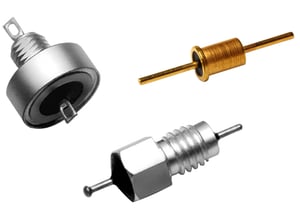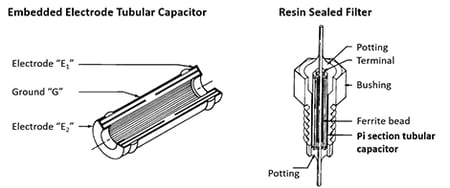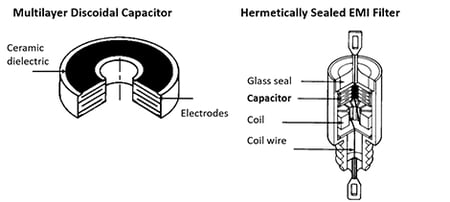Choosing the right type of EMI filter can be the difference between your electronics being fully functional and working properly or not. Although feedthrough and PC board filters are valid choices for EMI filter designs, there are advantages and disadvantages to making the right decision.
Some benefits of feedthrough EMI filters include:
- Cost effectiveness
- Improved insertion loss
- Extended frequency range
- Radiation exposure prevention
Keep reading to learn about the other advantages of choosing feedthrough filters.
Electromagnetic Interference Suppression
 EMI is the interference from one electronic device with another electronic device. EMI can be intentional or unintentional, continuous or intermittent, and at a single or across a broad range of frequencies. These scenarios have the potential to cause damage or disable electronic devices.
EMI is the interference from one electronic device with another electronic device. EMI can be intentional or unintentional, continuous or intermittent, and at a single or across a broad range of frequencies. These scenarios have the potential to cause damage or disable electronic devices.
Filter networks suppress EMI in two basic ways. The first is the capacitor elements shunt the interference to ground. The second is the series inductor elements, which raise the impedance of the line, improving the shunt capacitor elements even more.
Properly installed EMI filter components and integrated assemblies suppress interference on power and signal lines. This is very common in mission-critical, military defense, industrial, medical, and energy platforms.
What is a Feedthrough EMI Filter?
Feedthrough EMI filters are a cost-effective solution to suppress or eliminate the conducted interference of electronics. They provide superior insertion loss over a frequency range from just a few kHz up to 40 GHz. This type of filter is easy to install and is ideal for shielding applications.

Because of their physical geometry, the ceramic capacitor elements used in APITech’s line of EMI filters are often referred to as feedthrough capacitors or feedthrough EMI filters. The feedthrough design results in reduced self-inductance (compared to that of standard leaded capacitors). This design effectively prevents radiation from the input by coupling directly with the output of the capacitor. The combination of low inductance and high input/output isolation provides excellent shunting of EMI.
Read APITech’s Feedthrough EMI Filter Installation Guidelines for more information on the installation of Feedthrough EMI Filters.
Types of Feedthrough EMI Filters
 The simplest type of feedthrough EMI Filters is a ceramic tube that may have buried electrodes and can be constructed as a single capacitor or as two capacitors, as used in a Pi section filter. This type of device can have capacitance values from 10 pF to 0.1 µF and typical working voltage ratings up to 2500 VDC. Because of the simple construction, these capacitors are very efficient at frequencies up to 10 GHz and exhibit no pronounced resonances.
The simplest type of feedthrough EMI Filters is a ceramic tube that may have buried electrodes and can be constructed as a single capacitor or as two capacitors, as used in a Pi section filter. This type of device can have capacitance values from 10 pF to 0.1 µF and typical working voltage ratings up to 2500 VDC. Because of the simple construction, these capacitors are very efficient at frequencies up to 10 GHz and exhibit no pronounced resonances.
 Multilayer monolithic discoidal capacitors are used for very high capacitance parts in standard sizes or for smaller filters where the required capacitance cannot be achieved by a ceramic tube. This type of capacitor comprises alternate layers of opposite polarity electrodes separated by a ceramic dielectric. Typical capacitance values from 100 pF to 10 µF are available for working voltages up to 400 VDC.
Multilayer monolithic discoidal capacitors are used for very high capacitance parts in standard sizes or for smaller filters where the required capacitance cannot be achieved by a ceramic tube. This type of capacitor comprises alternate layers of opposite polarity electrodes separated by a ceramic dielectric. Typical capacitance values from 100 pF to 10 µF are available for working voltages up to 400 VDC.
Limitations of PC Board EMI Filters
Most electronic devices are manufactured using printed circuit boards (PCBs) and therefore most design engineers naturally want to install EMI filters on the PCB. PCB filters are capable of relatively high performance when the interference frequency is less than 1MHz. However, as the frequency increases above 1MHz, the effectiveness of PC board filtering is limited. There are two physical effects that design engineers must consider:
Effect #1 - Self-Resonant Frequency
Any capacitor running above its self-resonant frequency acts more like an inductor than a capacitor. This is the exact opposite of what is needed in a low pass EMI Filter.
Effect #2 - Lack of Shielding
Typically, EMI filters have shielding to isolate the input of the filter from the output.
Coupling of PC Board EMI Filters
Coupling between the input and output of a PC board filter can vary significantly at installation. Typically, there is no published data to quantify the coupling from input to output, but there are basic concepts that allow us to understand the effect.
Key to Feedthrough EMI Filter’s Excellent Performance
The key to a feedthrough filter’s performance is its metallic enclosure. A coaxial feedthrough capacitor passes a lead wire through the center and contains a ground plane that completely encircles the lead. Feedthrough capacitors do not turn into inductors at higher frequencies. Every leaded or surface mount capacitor does.
The metallic enclosure also provides the shielding that isolates the input from the output of the filter (especially above 1GHz). A feedthrough EMI filter can easily have a higher performance than the enclosure can provide.
Short of installing a mini shielded enclosure with feed-throughs directly on a printed circuit board, there is no physical way for a PC board EMI filter to match the performance of a feedthrough style EMI filter.
Final Thoughts
There are many EMI filtering options for Design Engineers. Two popular options are feedthrough and PCB EMI filters. Both have applications for which they are the perfect fit. For assistance in choosing the right EMI filter for your design, please contact Amy Brown, amy.brown@apitech.com
.jpg)

 News Blog
News Blog

Let Us Know What You Thought about this Post.
Put your Comment Below.